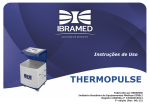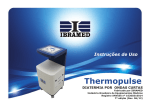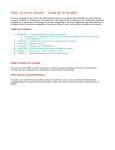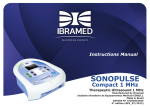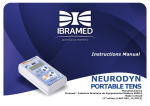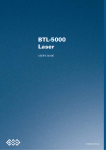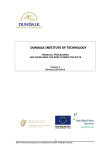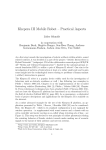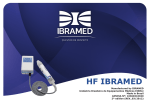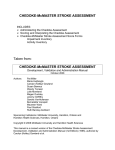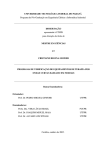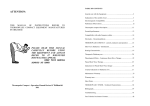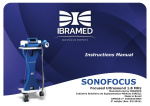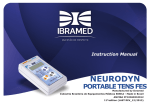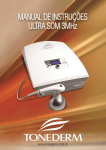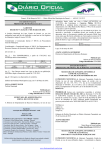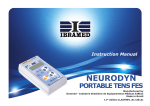Download Manual - Ibramed
Transcript
Instruction Manual Thermopulse Shortwave Diathermy Manufactured by Ibramed - Indústria Brasileira de Equipamentos Médicos EIRELI Made in Brazil ANVISA nº 10360310014 7ª Edition (Rev. 06/12) TABLE OF CONTENTS SYMBOL DEFINITIONS.................................................3 CARTON............................................................4 OPERATING INSTRUCTIONS........................................44 ABREVIATIONS GLOSSARY............................................5 PROGRAMMING EQUIPMENT........................................47 FIGURES DEFINITIONS................................................6 USING THE PROG/MENU BUTTON.................................49 FOREWORD................................................................7 PREPARING THE PATIENT FOR THERAPY........................50 PRODUCT DESCRIPTION..............................................7 REFERENCES............................................................57 ESSENTIAL PERFORMANCE ..................................7 TROUBLESHOOTING..................................................59 SAFETY PRECAUTIONS.................................................8 MAINTENANCE, WARRANTY AND TECHNICAL SUPPORT...59 INFORMATION ACCESSORIES ACCOMPANYING THERMOPULSE.............62 ABOUT SHORTWAVE DIATHERMY CEFAI – IBRAMED Center for Education and THERMOPULSE..........................................................15 Advanced Training................................................63 POPULATION AND CONDITIONS OF USE.......................22 GENERAL EQUIPMENT CARE........................................23 SHIPPING DAMAGE...........................................23 INSTALLATION, CARE AND CLEANING..................23 ELECTRICAL FEED.....................................................25 ELECTROMAGNETIC COMPATIBILITY GUIDANCE.............26 ELECTROMAGNETIC COMPATIBILITY.............................27 SPECIFICATIONS.......................................................34 SYSTEM SPECIFICATIONS..................................34 NOMENCLATURE........................................................36 Installing the applicators ..........................43 CONTROLS, INDICATORS AND CONNECTIONS.......36 SYMBOL DEFINITIONS...............................................39 ACCESSORIES USED..................................................42 2 SYMBOL DEFINITIONS BELOW ARE THE DEFINITIONS OF THE SYMBOLS USED ON THE EQUIPMENT AND THROUGHOUT THE INSTRUCTIONS FOUND IN THIS MANUAL. UNDERSTAND THESE SYMBOLS AND THEIR DEFINITIONS BEFORE OPERATING THIS EQUIPMENT. Caution! Refer to user manual. Class I Sensitivity Against Electrostatic Discharge. CLASS I Electrical Equipment . Off Switch. Not protected against the harmful On Swith. effects of water penetration. Non-ionizing Electromagnetic Radiation. Voltage in AC (Alternating Current). TYPE BF Electrical Equipment. Electrical Network (Alternating Current). Dangerous Voltage. 3 in AC SYMBOL DEFINITIONS CARTON Refer to operating correct product use. instructions Fragile. Manufacturer’s name and address. This side up. Limits of temperature for storage and packaging in °C (Celsius Degrees). Keep away from the rain. Do not stake. Do not use if the packaging is damaged. 4 for ABREVIATIONS GLOSSARY DOC Shortwave Diathermy DOCP Pulsed Shortwave Diathermy DOCA Automatic Pulsed Shortwave Diathermy CAP Capacitive IND Inductive SNT Tuning SB Stand By mm Millimeter cm Centimeter V~ Alternating Voltage Hz Hertz (pulses per second) kHz Kilohertz MHz Megahertz min Minute W Watts °C Celsius Degree V Volt VA Volt Ampere µA Microampere EMC Electromagnetic Compatibility RF Radiofrequency 5 FIGURES DEFINITIONS Figure 1. Upper Access Panel of THERMOPULSE.........34 Figure 16. Suggested placement: Electrodes in crossfire Figure 2. Front Access Panel of THERMOPULSE..........34 being A, half of the treatment is made with the electrodes Figure 3. Lateral Access Panel of THERMOPULSE........35 in the transverse position and B, the second half of the Figure 4. Rear Access Panel of THERMOPULSE...........35 electrodes are repositioned at right angles...................51 Figure 5. Capacitive electrodes..................................40 Figure 17. Suggested placement with inductive electrode.. Figure 6. A, Inductive electrode without clamping band ..............................................................................52 and B, inductive electrode with clamp band..................40 Figure 18. Suggested placement with inductive electrode.. Figure 7. Installing the capacitive electrodes...............41 ..............................................................................52 Figure 8. Installing the capacitive electrodes...............41 Figure 19. Suggested placement with inductive electrode.. Figure 9. Figures A, B and C show the message display ..............................................................................53 screen and default THERMOPULSE............................42 Figure 10. LCD displays the selected language.............47 Figure 11. Example: User 1 Protocol..........................47 Figure 12. Suggested placement: capacitive electrodes, parallel implementation.............................................49 Figure 13. Suggested placement: capacitive electrodes, parallel implementation.............................................49 Figure 14. Suggested placement: capacitive electrodes, transverse implementation.........................................50 Figure 15. Suggested placement: capacitive electrodes, longitudinal application..............................................50 6 FOREWORD PRODUCT DESCRIPTION This user manual allows the user to efficiently use the ESSENTIAL PERFORMANCE THERMOPULSE. Users must read, understand and follow the information in this manual for each mode of treatment available, as well as the indications, contraindications, warnings and precautions. The specifications and instructions in this manual are in effect at the time of its publication. These instructions may be updated at any time at the manufacturer’s discretion. Visit our website for updates. The THERMOPULSE electro medical equipment is a shortwave diathermy that generates radio frequency energy (high frequency 27.12 MHz) in the form of electromagnetic radiation intended for treatment of several pathologies. The interest in the use of high frequency radio frequency (shortwave) for therapeutic purposes dates back from 1892 when d’Arsonval (physician-physiologist) observed that frequencies of 10 kHz or more had the ability to produce heat in the tissues without causing painful muscle contractions or other harmful consequences that can occur at lower frequencies. This type of heat treatment has become popular because high frequency currents can penetrate more deeply into the tissues, with higher advantage when compared with other methods to heat the tissues superficially. The equipment is to be used only under the prescription and supervision of a licensed professional. 7 SAFETY PRECAUTIONS PRECAUTIONARY DEFINITIONS The precautionary instructions found in this section and throughout this manual are indicated by specific symbols. Understand these symbols and their definitions before operating this equipment prior to therapy session. • Read, understand, and practice the precautionary operating instructions. Know the limitations and hazards associated with using any shortwave diathermy device. Observe the precautionary and operational decals placed on the unit. • DO NOT operate the THERMOPULSE in conjunction with any other devices. • DO NOT operate the THERMOPULSE in an environment where other devices are being used that intentionally radiate electromagnetic energy in an unshielded manner. • Portable and mobile RF communications equipment can affect medical electrical equipment. • THERMOPULSE should be routinely checked before each use to determine that all controls function normally, especially that the output control does properly adjust the intensity of the shortwave diathermy power output in a stable manner. Also, determine that the treatment time control does actually terminate shortwave diathermy Text with a “CAUTION” indicator refers to potential safety infractions that could cause minor to moderate injury or damage to equipment. Text with a “WARNING” indicator refers to potential safety infractions that could cause serious injury and equipment damage. power output when the timer reaches zero. Text with a “DANGER” indicator refers to potential safety infractions that represent immediately life threatening situations that would result in death or serious injury. 8 SAFETY PRECAUTIONS • This unit should be transported and stored in temperatures between 5°C e 50°C (41°F e 122°F) to prevent damage to the unit or its components. • Handle shortwave diathermy accessories with care. Inappropriate handling of the accessories may adversely affect their technical characteristics. • Conductive material such as metal fittings must be removed from the immediate area of treatment. It is advisable to use the couch and wooden furniture (no metal parts). • The electrode cable must always be separated from one another and should not touch the patient. • The patient under treatment should not touch the equipment cabinet or metal objects such as windows, etc. Before starting treatment, make sure that the patient does this by removing bracelets, rings, watches, buckles or any metallic jewelry, including cell phone. • Inspect cables, electrodes, associated connectors, and accessories before each use. • External conductive material should be removed from the immediate treatment area. • Do not use accessories other than those supplied with the unit, or recommended by IBRAMED. The safety of other products has not been established, and their use could result in injury to the patient and degrade minimum safety. • Disconnect the power supply cord before removing covers on this equipment. Refer the servicing of this unit to qualified service personnel. • Electromedical equipment needs special precautions regarding EMC and needs to be installed and put into service according to the EMC information provided in this manual. • This unit generates, uses, and can radiate radio frequency energy and, if not installed and used in accordance with the instructions, may cause harmful interference to other devices in the vicinity. However, there is no guarantee that interference will not occur in a particular installation. Harmful interference to other devices can be determined by turning this equipment on and off. Try to correct the interference using one or more of the following: reorient or relocate the receiving device, increase the distance of separation between the equipment, connect the equipment to an outlet on a different circuit from that to which the other device(s) are connected, and consult the factory field service technician for help. 9 SAFETY PRECAUTIONS • Before treatment, it is necessary to know the operational procedures for the treatments available, as well as the indications, contraindications, warnings and precautions. • Since relatively high powers are used, there is the possibility of producing shock, localized burns, and cataracts if the patient is unaware of the heat due to reduced thermal sensation, or if the patient does not know what to expect during treatment. • Improper installation, operation or maintenance of the shortwave diathermy system may result in malfunctions of this unit or other devices. • In case of display failure or other obvious defects, switch • To determine the distance of separation for all equipment operating near the THERMOPULSE, consult the EMC tables applicable to the other equipment. • This equipment is to be used by, and sold to, a trained clinician only under the prescription and supervision of a licensed professional (see in RESPONSIBILITY FOR USE ELECTROMEDICAL EQUIPMENT). the unit off immediately by means of the power switch, disconnect the power cord from the power outlet, and notify a certified service technician. • Be aware that some synthetics and plastics, though assumed to be non-conductive, may be heated by shortwave diathermy. 10 SAFETY PRECAUTIONS • Adjustments or replacement of components may result in the equipment failing to meet the requirements for interference suppression. • If the unit cannot be installed immediately after delivery, the unit and its external components or accessory elements must be stored in their original packaging in a dry place. • Do not store or operate the unit in a dusty environment. • Do not cross cables. • Keep all electrodes, accessories, and their cords separated during treatment. Electrodes or their cords in contact with each other during treatment could result in improper • • • • • Use only accessories that are specially designed for this unit. Do not use accessories manufactured by other companies on this unit. IBRAMED is not responsible for any consequence resulting from using products manufactured by other companies. • The use of other accessories or cables (other than those specified) may result in increased emissions or decreased immunity of this unit. stimulation, skin burns, or damage to the cord or electrode. Do not lean on or hold the cables during treatment. This unit should not be stacked with other equipment used. Keep all line cords away from the diathermy unit cables. Do not store or coil line cords where they can come close to the cables on an operating shortwave diathermy unit. This equipment is not designed to prevent the penetration of water or liquids. Penetration of water or liquids could cause malfunction of internal components of the system and therefore create a risk of injury to the patient. 11 SAFETY PRECAUTIONS • Do not administer shortwave diathermy to a patient who has had an implant in the past unless you are absolutely certain that the implant and all leads in their entirety have been removed. Note that the leads are often left implanted after the implant is removed. • This unit generates non-ionizing radiation. Patients with implanted electronic devices, such as cardiac pacemakers and defibrillators, cochlear implants, bone growth stimulators, deep brain stimulators, spinal cord stimulators, and other nerve stimulators, must not be treated, even if the device has been turned off. • The function of certain implanted devices (e.g., pacemakers) may be adversely affected during treatment with shortwave diathermy. In case of doubt, the advice of a licensed professional in charge of the patient should be sought. • Shortwave diathermy should not be used on patients who have any implanted metallic lead or any implanted system that may contain a lead. • Other equipment, including patient connected devices, may be adversely affected when in close proximity to shortwave diathermy equipment. • Patients should not be treated with shortwave diathermy when they have reduced thermal sensitivity over the proposed area of treatment, unless the professional in charge of the patient is notified. • Treatment should not be given through clothing, although it is permissible to administer treatment through a dressing or plaster in pulsed modes. • Remove hearing aids prior to treatment. • Treatment must never be given with the patient on metal framed couches, chairs, or beds. Do not use conductive mattresses or mattress covers. • Before increasing the output in response to a report of inadequate patient heating, verify that the cables are properly routed, spaced correctly, and away from metal or grounded objects. The heating effect may be poorly distributed and heating may be occurring in an unwanted area. 12 SAFETY PRECAUTIONS • Before each use, check the condition of the housing and the insulation of the electrodes, electrode connection cable, and the power supply cable. Also make sure that the cables have been routed correctly. • If the unit is not safe for operation, then it must be repaired by certified service personnel and the operators must be informed of the dangers posed by the unit. • In order to prevent electrical shock, unplug the power plug from the socket before cleaning or disinfecting the unit. • Under no circumstances may liquid penetrate the openings on the unit, e.g. the connecting sockets of the electrode cables. Therefore, do not use cleaning or disinfectant sprays. • The unit, electrodes, and cables may not be sterilized using steam or gas. • Never clean the unit with abrasives, disinfectants or solvents that could scratch the cabinet or damage the unit. • Internal burns can occur with the incorrect application of shortwave diathermy due to excessive intensity. • Internal burns can occur with the incorrect application of shortwave diathermy due to excessive exposure time. • Do not perform unauthorized repairs under any circumstances. • There is explosion hazard if THERMOPULSE is used in the presence of anesthetics flammable when mixed with air, oxygen, or nitrous oxide. • The operator should not use diathermy over the heart in order to prevent potential cardiac signal interference. • Never, under any circumstances, attempt to hold any of the electrodes in your hands during therapy. • The unit must be installed so that there is no danger to the patient, the operator or other persons. Therefore, you must read the safety instruction and contraindications. 13 SAFETY PRECAUTIONS • Keep all unnecessary persons out of the treatment location. No other person should be located within 3 meters of the unit. • In case of damage from transport that could endanger personal safety, the unit must not be connected to the Main Power Supply before inspection is complete. • Adhere to rules, regulations, and ordinances that may vary from location to location concerning the appropriate use of high powered radio frequency fields. • The effects of high frequency fields on developing embryos and fetuses have not been sufficiently evaluated, we recommend pregnant operators to remain at least 15 meters away from the applicator when the unit is turned on. • Any persons with pacemakers or implants must remain outside the treatment area during shortwave diathermy. No one wearing a cardiac pacemaker should be within 15 meters of an operating unit. • The unit and the electrodes must be positioned so that there is no danger of personal injury. Therefore, you must read and observe the safety instructions and the list of contraindications before putting the unit into operation. 14 INFORMATION ABOUT SHORTWAVE DIATHERMY THERMOPULSE MODE - Shortwave Diathermy THERMOPULSE Shortwave Diathermy is performed by application of electromagnetic energy through the body tissues. The apparatus of shortwave diathermy consists of a sine wave generating circuit which produces a current with a frequency of 27.12 MHz and a resonant circuit can be tuned to the exact same frequency. THERMOPULSE produces electric fields and magnetic fields oscillating currents of high frequency alternating fields and these are the fields which produce the physiological effects and therapeutic benefits. This electromagnetic frequency energy is converted into thermal energy by inducing currents circulating in the insulating tissue. The heating effect produced by shortwave diathermy aids the healing process, generating heat deep into the tissue, resulting in numerous beneficial effects. The mode of application of THERMOPULSE may also be pulsed (shortwave pulsed non-thermal), i.e., it allows shots to emit electromagnetic energy in pre-programmed intervals of time, minimizing the thermal effect for the control of pain, edema and accelerating the healing. Shortwave Diathermy of Level Thermal • In SWD mode (Shortwave Diathermy), THERMOPULSE produces a detectable warming in the deep tissues; this is called thermal level diathermy. The heat produced is proportional to the applied energy density and higher heating occurs in tissues with higher conductivity. The intensity of power is given in watts (10 to 150 W). Shortwave Diathermy Level Non-Thermal (Imperceptible) • In the PSWD mode (Pulsed Shortwave Diathermy), THERMOPULSE provides pulsed shortwave diathermy, through a circuit in which the synchronized mode can be switched on and off, enabling shots to be emitted with variable frequency oscillation of 50 to 800 Hz in time durations 100 to 400 µs with increments of 10 µs. • In the mode ASWD (Automatic Pulsed Shortwave Diathermy) THERMOPULSE works always in the maximum power (150W) but automatically runs a series of scanning frequencies of 50 Hz to 160 Hz and 160 Hz to 50 Hz in steps of 10 Hz. 15 INFORMATION ABOUT SHORTWAVE DIATHERMY THERMOPULSE AUTOMATIC TUNING: Whatever the mode chosen SWD, SWDP or ASWD, THERMOPULSE will tune the circuit automatically to ensure always the maximum transfer of radiofrequency energy in treatment. RESPONSIBILITY FOR USE ELECTROMEDICAL EQUIPMENT The use of electromedical equipment is restricted to a physician or under his command, the physical therapists or health professionals properly licensed. The professional will be responsible for properly licensed use and operation of the equipment. IBRAMED makes no representations regarding laws and federal, state or local laws that may apply to the use and operation of any electromedical equipment. The physician or under his command, also the physical therapist or other professional health care licensed assumes total and full commitment to contact the local certifying agencies to determine any credential required by law for clinical use and operation of this equipment. The use of electromedical equipment must comply with the local, state and federal country. 16 INDICATIONS, CONTRAINDICATIONS, PRECAUTIONS AND ADVERSE REACTIONS INDICATIONS INDICATIONS Osteoarthritis: Chronic and acute joint disorders (knee, hip, shoulder, elbow, hand, foot and mandibular joints). Ischialgia: Pain in ending of nervus ischiadicus, always radicular, usually caused by damaged intervertebral disc. Chronic Polyarthritis of the Hip and Shoulder Joints: Inflammation of more than one joint. Contracture: Loss of motion in a joint due to the shortening of soft tissue. Tendonitis/Tendinosis: Chronic and acute inflammation or injury to the tendons. Lumbago: Muscle pain in the lumbar region, lumbar rheumatism. Shin Splints: Painful condition of the shins. Myalgia: Muscle pain. Bursitis: Bursal synovitis. Neuralgia/Neuritis: Nerve pain, nerve inflammation. Distortions, Dislocations, and Contusions: Twisted joints, overextended joints, sprains, dislocations (luxation), crushing, or injury due to brute force (contusion). Frozen Shoulder: Shoulder pain accompanied by limitation of movement. Periostitis: Cortical osteitis. Epicondylitis: Tennis elbow, inflammation of tendon attachments on cubital or radial part of elbow joint (humeral). Fibrositis/Fibromyalgia: Condition presence of chronic widespread pain. classified by the Spondylosis / Osteochondrosis: Arthrosis of the vertebral bodies or degeneration of the intervertebral discs. Sinusitis: Inflammation of the paranasal passages. Fractures: Broken bones. Carpal Tunnel Syndrome Medical: condition in which median nerve is compressed at the wrist causing pain and muscle weakness. Intercostal Neuralgia: Nerve pain. Acute, painful irritation starting from the thoracic spine; Possible causes of this are nerve root compressions and acute blockages in the area of the kinetic elements or the joint faces of the vertebral bodies. Tendovaginitis: Inflammation of tendon and sheath; Painful grating or chafing of the affected tendon after overstraining or dull trauma. 17 INDICATIONS, CONTRAINDICATIONS, PRECAUTIONS AND ADVERSE REACTIONS INDICATIONS PRECAUTIONS Cervical syndrome: Post-traumatic neck syndrome; Refers to afflictions beginning in the cervical spine that can emanate into the shoulder muscles or arms. Obese patients: diathermy should be used with caution in obese patients because it can overly heat up the fat. Piriformis Syndrome: Neuromuscular disorder when sciatic nerve is compressed or otherwise irritated by the piriformis muscle. Intrauterine contraceptive devices containing copper: the intrauterine contraceptive (IUDs) containing copper have a small amount of metal and do not constitute risk for women for treatment with short-wave. Morton’s Neuroma: Benign neuroma of the interdigital plantar nerve. Plantar Fasciitis: Inflammatory condition of the foot caused by excessive wear to the plantar facia that supports the arch. Rotator Cuff Tear/Repair: Tears of one or more of the four tendons of the rotator cuff muscles. Torticollis: Condition in which head is tilted to one side, chin elevated and turned to opposite side. Plica Syndrome: Occurs when plica in the knee becomes irritated or inflamed. Retropatellar Pain Syndrome: Inflammation of the patellar tendon in the knee. 18 INDICATIONS, CONTRAINDICATIONS, PRECAUTIONS AND ADVERSE REACTIONS CONTRAINDICATIONS CONTRAINDICATIONS Cardiac pacemakers and implanted stimulators. • Patients whose condition could be negatively affected by heat. • Patients with hemorrhages or risk of hemorrhage. • Patients with septic conditions and empyemas. • Patients with malignant tumors and undiagnosed tumors. • Implants, areas where implants have been removed, damaged implants, and metal inclusions. • Implants that could be impaired by shortwave diathermy irradiation. • Swellings that still feel warm. (diminished perception of • Thermohypesthesia temperature differences). • Thermohyperesthesia (very acute thermoesthesia or temperature sense; exaggerated perception of hot and cold). • Acute inflammations. • Severe arterial obstructions (stage III and IV). • Gynecological disorders involving acute inflammation. Any patient with an implanted electronic device such as a cardiac pacemaker, bladder stimulator, spinal cord stimulator or electrodes for a myoelectric prosthesis, or implanted metallic leads, must not be treated with shortwave diathermy and should not be subjected to shortwave diathermy. Do not use on patients who have had an implant in the past unless you are absolutely certain that the implant and all leads in their entirety have been removed. Note that leads are often left implanted after the implant is removed. The effects of the applied high frequency on the pacemaker could cause ventricular fibrillation. Any other persons with pacemakers must also remain outside of the treatment area during shortwave diathermy. No one wearing a cardiac pacemaker should be within 10 meters of an operating unit. 19 INDICATIONS, CONTRAINDICATIONS, PRECAUTIONS AND ADVERSE REACTIONS CONTRAINDICATIONS CONTRAINDICATIONS • Wetness, perspiration, or damp bandages. • Permeating irradiation of the thorax in cases of severe heart diseases (heart valve diseases, myocardial insufficiency, myocardium infarct, severe coronary sclerosis). • Pregnancy, since irradiation of the abdomen could cause teratogenous damage due to alterations of blood circulation and diffusion. • Over the pregnant or potentially pregnant uterus. • Therefore, shortwave diathermy should not be applied over the uterus unless specific assurance can be attained from the patient that she is not pregnant. • Sudeck’s syndrome, stage I and II. • Basedow-Graves’ disease (irradiation could cause serious states of agitation). • Varicose veins (irradiation could cause congestive pain). • Particular care must be taken if the patient’s clothing is wet or damp, since the garments may heat up faster and more intensely than the patient’s body. • Synthetic fibers (perlon, nylon, etc.) are characterized by low absorbency, which can cause the skin beneath such fabrics to quickly become moist. Therefore, it is recommended that the body areas to be treated be completely unclothed and the patient’s skin dried, particularly where perspiration accumulates in folds of the skin. • • • • • 20 • • • This applies especially when a higher dosage is being applied. There is no danger, however, when applying shortwave diathermy irradiation to bandaged areas as long as the bandages are completely dry. When treating small children, particular care is obviously required due to the low body weight. Very careful dosing and constant observation (manual checks of the skin temperature while the unit is switched off) are necessary. Since the effects of high-frequency fields on unborn life have not yet been sufficiently researched, we recommend that operators who are pregnant are not within 15 meters of the applicator when the unit is activated. The output power must always be set according to the subjective response of the patient. Therefore, special care must be taken in case of patients with a diminished capacity for perception of heat. It is advisable to post warnings for wearers of pacemakers in the rooms where high-frequency therapy (e.g. shortwave diathermy) is applied. A distance of at least 12 meters (see the Caution on page 6 for more information) must be maintained between the unit and any low-frequency therapy that is being used. Cardiac conditions. Deep vein thrombosis, phlebitis, varices. Arterial disease, circulatory insufficiency. INDICATIONS, CONTRAINDICATIONS, PRECAUTIONS AND ADVERSE REACTIONS CONTRAINDICATIONS ADVERSE REACTIONS • Burns: short-wave diathermy may cause burns to soft tissues when used in excessive doses. To avoid burning the patient’s skin should be kept dry. • Over eyes. • Over reproductive organs. • Over cardiac pacemakers and defibrillators, cochlear implants, bone growth stimulators, deep brain stimulators, spinal cord stimulators, and other nerve stimulators. • Over open lamina (after laminectomy; spina bifida). • Over superficial endoprosthesis or metal implants. Directly over the carotid sinuses, cervical stellate ganglion, or Vagus nerve located in the anterior neck triangle. • Direct application over cancerous tumors or lesions due to its potential to increase blood flow to the area of malignancy. • Neoplastic tissues or space occupying lesions. • Occlusive vascular disease, such as arteriosclerosis obliterans and thromboangitis obliterans, in which organic occlusion and ischemia are evident. • Directly over the epiphysis of growing bones in children and adolescents because shortwave diathermy therapy may enhance or inhibit bone growth. 21 POPULATION AND CONDITIONS OF USE PATIENT POPULATION • Patients over 12 years old, under this age only by medical prescription or physiotherapeutic indication; • Patients over 35 kg, under this weight only by medical prescription or physiotherapeutic indication; • There are no restrictions as of nationality; • Patients with preserved level of conscience and sensitivity. • There are no admissible deficiencies for the use of the equipment; • Regarding the frequency of use, this device is used according to clinical needs, up to several times a day and is reusable; • Regarding mobility, this device is considered a portable device. CONDITIONS OF USE • There are no requisites about a maximum level of education for the intended use. • Regarding the minimum level of knowledge of the user, it is necessary that the user knows the electro physical agents and their therapeutical effects. The user must know physiology, anatomy, and the basic sciences: chemistry, physics, and biology. The user is supposed to have studied or be presently studying physiology and anatomy; • A maximum level of knowledge is not required from the user; • The instructions of use are available in Portuguese, Spanish and English; • Regarding the minimum level of experience of the user, it is necessary that the instructions of use are read carefully and all the instructions are understood before the use of the device; 22 GENERAL EQUIPMENT CARE SHIPPING DAMAGE INSTALLATION, CARE AND CLEANING Your THERMOPULSE is shipped complete in one carton. Upon receipt, inspect carton and unit for visible and hidden damage. In case of damage, keep all shipping materials including carton and contact the shipping agent responsible for the delivery of the unit. All claims relating to damage during transport should be filed directly with them. The manufacturer will not be liable for any damage during shipping, nor allow for adjustments unless proper formal claim has been filed by the receiver against the carrier. The carton in which your THERMOPULSE was received is specially designed to protect the unit during shipping. Please keep all shipping materials in case you need to return your unit for servicing. Installation Instructions 1. Connect the line cord to the back of the THERMOPULSE. 2. Plug the line cord into a grounded wall outlet (100/240V - 50/60 Hz). 3. Plug the electrode cables into the electrode cable connections. 4. Switch on your equipment. CORRECT EQUIPMENT INSTALLATION PREVENTS SECURITY RISKS 23 GENERAL EQUIPMENT CARE THERMOPULSE Care Instructions Environmental Protection • Avoid areas subject to vibrations. • Install the equipment on a firm and level surface, in open air. • Do not block ventilation. • Avoid humid, hot and dusty environments. • Make sure the area around the network cable is free. • Do not insert objects into device holes. The THERMOPULSE is an electronic device and has heavy metals such as lead. Thus, there are risks of contamination to the environment associated with the disposal of this equipment and its accessories at the end of their useful lives. The THERMOPULSE, parts and accessories must be disposed of as waste. Contact your local distributor for information on rules and laws regarding the disposal of waste electrical, electronic equipment and accessories. Cleaning the THERMOPULSE • Disconnect the system from the power source, wipe with a clean, lint free cloth moistened with water and mild antibacterial soap. • If a more sterile cleaning is needed, use a cloth moistened with an antimicrobial cleaner. • Do not place the system in liquids. THE DEVICE AND ITS CONSUMABLE PARTS MUST BE DISPOSED OF, AT END OF LIFE, ACCORDING TO THE APPLICABLE FEDERAL AND/OR STATE AND /OR LOCAL REGULATIONS. 24 ELECTRICAL FEED THERMOPULSE is monophasic equipment, and it may be connected to mains voltage in the range of 100 to 240 volts 50/60 Hz. Just connect the equipment to the power supply line and it will perform the of selection mains voltage automatically. The connecting cable to the power line is detachable. The equipment uses a mains plug as a resource to electrically separate its circuits in relation to the mains power in all the poles. Before turning on THERMOPULSE, make sure: • The tension and frequency of the local mains voltage is equal to the one described on the label of power line and tension characteristics located in the rear part of the equipment. • To prevent electrical shock, do not use the plug in the equipment as an extension cable, or other types of plugs except the terminals fit completely in the receptacle. • Cleansing and disinfection must be performed with the power plug disconnected from the mains voltage. • Maintenance and technical assistance of THERMOPULSE must always be performed at an authorized technical service only by qualified technicians. NOTES In the rear part of THERMOPULSE there is a protection fuse. To replace it, turn the equipment off of the mains voltage line and with a screwdriver, remove the protection lid, disconnect the fuse and perform the replacement, then replace the protection lid. Always use the fuses indicated by Ibramed. Use the fuse for the nominal current of 5.0A, operation tension 250V~ and snap action model 20AG (rupture current of 50A). THERMOPULSE does not need any type of current stabilizer. Never use power stabilizers. 25 ELECTROMAGNETIC COMPATIBILITY GUIDANCE • This unit is not designed to be used where there is explosion hazard, such as anesthesia departments or in the presence of an anesthetic flammable when mixed with air, oxygen or nitrous oxide. • Using cables, electrodes and other accessories from other manufacturers and/or different from those specified in this manual as well as the replacement of internal components THERMOPULSE may result in increased emissions or decreased immunity of the equipment. • THERMOPULSE equipment is intended for use only by healthcare professionals. The THERMOPULSE may cause radio interference or disrupt equipment operations nearby. It may be necessary to adopt mitigation procedures, such as reorienting or relocating the equipment or shielding of the site. • Portable and Mobile Radio Frequency (RF) communications equipment can affect Medical Electrical Devices. 26 ELECTROMAGNETIC COMPATIBILITY Guidance and Manufacturer’s Declaration - Electromagnetic Emissions The THERMOPULSE is intended for use in the electromagnetic environment specified below. The customer or the user of the THERMOPULSE should ensure that it is used in such an environment. Emission Test Compliance RF Emissions CISPR 11 Group 1 RF Emissions CISPR 11 Class B Harmonic Emissions IEC 61000-3-2 Applicable Voltage fluctuations/ flicker emissions IEC 61000-3-3 Applicable Electromagnetic environment - guidance The THERMOPULSE must emit electromagnetic energy in order to perform it’s intend function. Nearby electronic equipment may be affected. The THERMOPULSE is suitable for use in all establishments other than domestic those directly connected to the public low-voltage power supply network that supplies buildings used for domestic purposes. 27 ELECTROMAGNETIC COMPATIBILITY Guidance and Manufacturer’s Declaration - Electromagnetic Immunity The THERMOPULSE is intended for use in the electromagnetic environment specified below. The customer or the user of the THERMOPULSE should assure that it is used in such an environment. IEC 60601 Test Level Immunity Test Electrostatic discharge (ESD) IEC 61000-4-2 Electrical fast transitories/burst IEC 61000-4-4 Surge IEC 61000-4-5 Compliance Level +6 - kV by contact + 8 kV by air - +6 - +2 - kV for power supply lines + 1 kV for input/ output lines +2 - +1 - +1 - kV differential mode + 2 kV common mode kV by contact + 8 kV by air - kV for power supply lines + 1 kV for input/ output lines kV differential mode + 2 kV common mode 28 Electromagnetic Environment - Guidance Floors should be wood, concrete or ceramic tile. If floors are covered with synthetic material, the relative humidity should be at least 30%. Mains power quality should be that of a typical commercial or hospital environment. Mains power quality should be that of a typical commercial or hospital environment. ELECTROMAGNETIC COMPATIBILITY Guidance and Manufacturer’s Declaration - Electromagnetic Immunity The THERMOPULSE is intended for use in the electromagnetic environment specified below. The customer or the user of the THERMOPULSE should assure that it is used in such an environment. Immunity Test Voltage dips, short interruptions and voltage variations in power input lines IEC 61000-4-11 Power frequency (50/60 Hz) magnetic field IEC 60601 Test Level Compliance Level < 5% UT (> 95% voltage drops in UT ) 0.5 by cycle < 5% UT (> 95% voltage drops in UT ) by 0,5 ciclo 40% UT voltage drops in (60% UT ) by 5 cycles 40% UT (60% de voltage drops in UT ) by 5 cycles 70% UT (30% voltage drops in UT ) by 25 cycles 70% UT (30% voltage drops in UT ) by 25 cycles < 5% UT (> 95% voltage drops in UT ) by 5 seconds < 5% UT (> 95% voltage drops in UT ) by 5 seconds 3 A/m Electromagnetic Environment - Guidance Mains power quality should be that of a typical commercial or hospital environment. If the user of the THERMOPULSE requires continued operation during power mains interruptions, it is needed that the THERMOPULSE be powered from an uninterruptible power supply or battery. Power frequency magnetic fields should be at levels characteristic of a typical location in a typical commercial or hospital environment. 3 A/m IEC 61000-4-8 NOTE: UT is the A.C. mains voltage prior to applications of the test level. 29 ELECTROMAGNETIC COMPATIBILITY The THERMOPULSE is intended for use in the electromagnetic environment specified below. The customer or the user of the THERMOPULSE should assure that it is used in such an environment. Immunity Test IEC 60601 Test Level Compliance Level Electromagnetic Environment - Guidance Portable and mobile RF communication equipment should not be used no closer to any part of THERMOPULSE, including cable than be separation distance calculated from the equation applicable to the frequency of the transmitter. Conducted RF IEC 61000-4-6 3 Vrms 150 kHz to 80 MHz Recommended separation distance 3V d = 1.2 d = 0.35 d = 0.7 Radiated RF IEC 61000-4-3 10 V/m 80 MHz to 2.5 GHz 10 V/m P P 80 MHz to 800 MHz P 800 MHz to 2.5 GHz Where P is the maximum output power rating of the transmitter in watts (W) according to the transmitter manufacturer and d is the recommended separation distance in meters (m). Field strengths from fixed RF transmitters, as determined by an electromagnetic site survey,a should be less than the compliance level in each frequency range.b 30 ELECTROMAGNETIC COMPATIBILITY Guidance and Manufacturer’s Declaration - Electromagnetic Immunity The THERMOPULSE is intended for use in the electromagnetic environment specified below. The customer or the user of the THERMOPULSE should assure that it is used in such an environment. Immunity Test IEC 60601 Test Level Compliance Level Conducted RF IEC 61000-4-6 3 Vrms 150 kHz to 80 MHz 3V Radiated RF IEC 61000-4-3 10 V/m 80 MHz to 2.5 GHz 10 V/m Electromagnetic Environment - Guidance Interference may occur in the vicinity of equipment marked with the following symbol: NOTE 1: At 80 MHz and 800 MHz the higher frequency range applies. NOTE 2: These guidelines may not apply in all situations. Electromagnetic propagation is affected by absorption and reflection from structures, objects and people. Field strengths set by fixed transmitters, such as radio base stations, telephone (cellular/cordless) telephones and land mobile radios, amateur radio, AM / FM radio broadcast and TV broadcast cannot be predicted theoretically with accuracy. To assess the electromagnetic environment due to fixed RF transmitters, an electromagnetic site survey should be considered. If the measured field strength at the location in which the THERMOPULSE is used exceeds the applicable RF compliance level above, the THERMOPULSE should be observed to verify normal operation. If abnormal performance is observed, additional measures may be necessary, such as reorientation or relocating the THERMOPULSE. a b Over the frequency range 150 kHz to 80 MHz, field strengths should be less than 10 V/m. 31 ELECTROMAGNETIC COMPATIBILITY Recommended separation distances between the mobile RF communication equipment and THERMOPULSE The THERMOPULSE is intended for use in an electromagnetic environment in which radiated RF disturbances are controlled. The customer or the user of the THERMOPULSE can help prevent electromagnetic interference by maintaining a minimum distance between portable and mobile RF communications equipment (transmitters) and the THERMOPULSE as recommended below, according to the maximum output power of the communications equipment. Rated maximum power output of transmitter w 0.01 Separation distance according to frequency of transmitter m 150 kHz to 80 MHz d = 1.2 P 80 MHz to 800 MHz d = 0.35 0.12 P 0.035 800 MHz to 2.5 GHz d = 0.7 P 0.07 0.1 0.38 0.11 0.22 1 1.2 0.35 0.7 10 3.8 1.1 2.2 100 12 3.5 7 For transmitters rated at a maximum output power not listed above, the recommended separation distance d in meters (m) can be estimated using the equation applicable to the frequency of the transmitter, where P is the maximum output power rating of the transmitter in watts (W) according to the transmitter manufacturer. NOTE 1: 80 MHz to 800 MHz, the separation distance for the higher frequency range applies. NOTE 2 These guidelines may not apply in all situations. Electromagnetic propagation is affected by absorption and reflection from structures, objects and people. 32 ELECTROMAGNETIC COMPATIBILITY Aparelho: Número de série: Registro ANVISA (M.S.): Data de fabricação: Prazo de validade: 5 anos Engenheiro responsável: Maicon Stringhetta 33 SPECIFICATIONS SYSTEM SPECIFICATIONS Dimensions Width: Depth: Height: Standard Weight (without accessories) Potência 39 cm (15.3 in) 38 cm (14.9 in) 76 cm (29.9 in) 27.5 kg Input: 100 / 240~ 50/60 Hz Input Power: 800 VA Electrical Class: CLASSE I Fuses: 5A 250~ (20AG) Degree of Electrical Protection: TYPE BF Output frequency: 27.12 MHz ± 0.6% Mode: SWD (Shortwave Diathermy) PSWD (Pulsed Shortwave Diathermy) ASWD (Automatic Pulsed Shortwave Diathermy) Capacitive Mode Output Power: 10 to 150 W (50 ohms) Inductive Mode Output Power: 10 to 80 W (50 ohms) Power Increments: 10 W Pulse width: 100 to 400 µs Pulse Frequency: 50 to 800 Hz Treatment time: 1-60 minutes (1 minutes increments) Capacitive Electrode Area: 270 cm2 (each electrode) Inductive Electrode Area: 85 cm2 34 SYSTEM SPECIFICATIONS Regulatory Compliance IEC 60601-1 IEC 60601-1-2 IEC 60601-2-3 IEC 60601-1-4 Temperature Range During Transport and Storage: 5 - 50°C/ 41 - 122°F. Environment operating temperature range: 5 - 45°C/ 41- 113°F. ISO 10993-1 - Biocompatibility IBRAMED declares that the materials with which THERMOPULSE is manufactured do not cause allergic reactions or sensitivity; there is no risk of harmful effects to cells or skin irritation potential. 35 NOMENCLATURE CONTROLS, INDICATORS AND CONNECTIONS Figure 2. Front Access Panel of THERMOPULSE. Figure 1. Upper Access Panel of THERMOPULSE. 36 NOMENCLATURE CONTROLS, INDICATORS AND CONNECTIONS Figure 3. Lateral Access Panel of THERMOPULSE. 37 Figure 4. Rear Access Panel of THERMOPULSE. NOMENCLATURE CONTROLS, INDICATORS AND CONNECTIONS 1- Power ON/OFF Switch. 13- Line Cord Connection. 2- Power ON Indicator LED. 14- Label of Power and Voltage. 3- BACK/NEXT Buttons. 15- General Characteristics and Serial Number. 4- SET + /SET - Buttons. SET + increase and SET – decrease. 16- Federal Law (only USA). 5- LCD user interface. 6- START/STOP Buttons. 7- UP/DOWN Buttons. 8- PROG/MENU Button. PROG: User Protocol; MENU: Select Language (Português, English and Español). 9- Output Connector Capacitive Electrodes. 10- Technical Characteristics Label. 11- Output Sockets Inductive Electrode. 12- Protection Fuse. 38 SYMBOL DEFINITIONS Read and understand these symbols and their definitions before operating this equipment SWD (Shortwave Diathermy), PSWD (Pulsed Shortwave Diathermy) or ASWD (Automatic Pulsed Shortwave Diathermy). CAP (capacitive) or IND (inductive). Only PSWD mode: 10 Hz to 800 Hz (steps of 10 Hz). Only PSWD mode: 100µs to 400µs (steps of 10µs). 39 SYMBOL DEFINITIONS Read and understand these symbols and their definitions before operating this equipment Relative Percentage of RF output (intensity) to the patient: 0%, 25%, 50%, 75% and 100%. The bar graph indicates the percentage of segments of tune and informs about the percentage of RF transmitted to the patient. When searching for tuning, the display shows the symbol TNG (tuning). SWD: variable from 10 W to 150 W PSWD or ASWD: fixed at 150 W (peak). Treatment time: 1-60 min. Button used to START or STOP the treatment. Always press the center key. Dual function Button: PROG selection and programming of new protocols (10 user protocols); MENU selection of language (Português, English or Espanõl). 40 SYMBOL DEFINITIONS Read and understand these symbols and their definitions before operating this equipment Move the cursor to the next parameter. Move the cursor to the previous parameter. Parameters increase. Parameters decrease. UP or DOWN Intensity of power buttons. 41 ACCESSORIES USED ELECTRODES APPLICATORS A B Figure 5. Capacitive electrodes. Figure 6. A, Inductive electrode without clamping band and B, inductive electrode with clamp band. 42 ACCESSORIES USED Installing the applicators Figure 7. Installing the capacitive electrodes. Figure 8. Installing the inductive electrode. 43 OPERATING INSTRUCTIONS Preparing the Device Connect the power supply cord to an appropriate electrical outlet and into the IEC connector on the lateral panel. Press the power switch. LCD displays the device’s message presentation for a few seconds, followed by the software model of the device default screen programming (Figure 9). A B C Figure 9. Figures A, B and C show the message display screen and default THERMOPULSE. Note that when you enter the default screen the letter “S” word SWD will flash. This is the parameter selection cursor that appears when the device is available for programming. 44 OPERATING INSTRUCTIONS Preparing the Device Time Parameters Edit Parameters The BACK/NEXT buttons allow you to select the parameters required for the treatment. Press the NEXT button for the cursor to move to the next parameter. Press the BACK button for the cursor to move back to the previous setting. Set the session time. At the end of the scheduled time, you will hear a beep indicating that the emission shortwave has been interrupted. Press the STOP button, so that the sound signal turns off and the equipment goes back to the programming status. The SET + / SET - buttons allow you to select the values of each parameter required for the treatment. Select Shortwave Mode Prepare and Install Patient Switch Press SET + or SET - to select the device shortwave mode you wish to use for the treatment: SWD (Shortwave Diathermy), PSWD (Pulsed Shortwave Diathermy) or ASWD (Automatic Pulsed Shortwave Diathermy). Prepare the patient for therapy as described and read about the use of capacitive electrodes and inductive electrode. 45 OPERATING INSTRUCTIONS Prepare and Install Patient Switch Prepare the patient for therapy as described and read about the use of electrodes. Start Treatment Press the START button to begin therapy session. Stop Treatment Press the STOP button to end therapy session. Shortwave Intensity The shortwave Intensity may be increased or decreased at any time during the session. Press the UP or DOWN buttons. 46 PROGRAMMING EQUIPMENT Example: Suppose that to treat a specific pathology, you need to select the following parameters: Mode = Pulsed Electrode Type = Capacitive Pulse Frequency = 30 Hz Pulse Width = 300 µs Treatment time = 20 min 2. Press the SET + button until PSWD (pulsed mode) is displayed, as shown below: 1. Connect the equipment to start programming the pattern described above. Note the blinking cursor in the SWD. 3. With the NEXT/BACK and SET + / SET - keys, scroll through the other parameters and select the values shown in the example: 47 PROGRAMMING EQUIPMENT 4. Now press the START button to start treatment. Note that the “flashing” cursor and the letters SB (stand by) disappear and now the display shows the operation seeking through a tuning bar graph display and the letters TNG (tuning appear). It may be necessary to adjust the position of the electrodes on the patient to improve the tuning. 5. With the UP or DOWN keys select the intensity of power required for treatment. (See in section ORIENTATION ABOUT DOSAGE) 6. At the end of the programmed time, the emission of current is interrupted and an audible alarm will signal the end of treatment. 7. Press the STOP button to stop the alarm. The equipment can now be switched off, and it will be ready to repeat the same programming task, or undertake a new programming task. 48 USING THE PROG/MENU BUTTON USING THE MENU BUTTON USING THE PROG BUTTON/ PROGRAMMING USER PROTOCOLS The PROG/MENU button is used to select the language. Press PROG/MENU until you hear three “beeps.” Select the desired language: ‘Português’, ‘Español or ‘English’ (Figure 10). Briefly press the PROG/MENU to set the chosen language. THERMOPULSE offers the possibility to record your protocols. To program new protocols, briefly press the PROG/MENU. With the buttons SET + and SET- choose one of available user protocols (1 to 10). Choose the parameters as explained previously in the PROGRAMMING EQUIPMENT section and press START. The last choice will be recorded as a protocol in the memory of the device. To access protocols saved by the user, simply select the PROG/MENU key and use the SET + and SET - buttons - to select the desired protocol number. To view the previously recorded the protocol selected, press the key PROG / MENU. To start treatment, press START. Figure 10. LCD displays the selected language. Figure 11. Example: User 1 Protocol. 49 PREPARING THE PATIENT FOR THERAPY THERMOPULSE POSITION OF ELECTRODES Before applying shortwave diathermy to the patient, you must first prepare the patient’s skin. By properly preparing the patient’s skin for shortwave diathermy, you will allow more energy to reach the targeted areas and reduce the risk of skin irritation. Capacitive Method The capacitive method on the THERMOPULSE uses flexible plates electrodes wrapped in thick silicon that can be positioned according to therapeutic needs. The capacitive method may be applied in different ways as shown: • Parallel (coplanar): parallel to the same side of the area to be treated to treat more superficial structures, e.g. the spinal musculature. • Transverse (contraplanar): place electrodes on opposite sides of the area to be treated, parallel to the area and not each other, to treat structures located deeply, e.g. joints. • Longitudinal: electrodes are positioned so that energy passes transversely to the tissue area to be treated to achieve structures located deeply. • Crossfire: half the treatment is performed with the electrodes in one Transverse position and the second half of the electrodes are repositioned at right angles. To prepare the patient’s skin for shortwave diathermy, do the following: 1. Instruct the patient on therapy 2. Expose the area to be treated and position the patient comfortably 3. Examine the area to be treated 4. If necessary clean the skin with mild soap and water or alcohol 5. Dry skin if it is damp 6. Place the electrodes in relation to tissues and proper distance. Before using the unit, verify if the patient is not in contact with the unit, with the electrode connection cable, with the electrodes, or with other devices or metal objects. 50 PREPARING THE PATIENT FOR THERAPY THERMOPULSE POSITION OF ELECTRODES Capacitive Method Figure 13. Suggested placement: capacitive electrodes, parallel implementation. Figure 12. Suggested placement: capacitive electrodes, parallel implementation. 51 PREPARING THE PATIENT FOR THERAPY THERMOPULSE POSITION OF ELECTRODES Capacitive Method Figure 15. Suggested placement: capacitive electrodes, longitudinal application. Figure 14. Suggested placement: capacitive electrodes, transverse implementation. 52 PREPARING THE PATIENT FOR THERAPY THERMOPULSE POSITION OF ELECTRODES Capacitive Method B A Figure 16. Suggested placement: Electrodes in crossfire being A, half of the treatment is made with the electrodes in the transverse position and B, the second half of the electrodes are repositioned at right angles. 53 PREPARING THE PATIENT FOR THERAPY THERMOPULSE POSITION OF ELECTRODES Inductive Method – Inductothermy The inductive THERMOPULSE electrode is in the form of flat and spiral helix contained in the drum (monode) to be applied parallel to the skin surface. In inductive treatments position the inductive electrode in relation to the treatment area and use the elastic band to affix as shown. Figure 18. Suggested placement with inductive electrode. Figure 17. Suggested placement with inductive electrode. 54 PREPARING THE PATIENT FOR THERAPY THERMOPULSE POSITION OF ELECTRODES Inductive Method – Inductothermy Figure 19. Suggested placement with inductive electrode. 55 PREPARING THE PATIENT FOR THERAPY ORIENTATION ABOUT DOSAGE The intensity of power considering the feedback dosage should be used must be adjusted according to the therapeutic requirements and particularly of the patient on his thermal sensation, as shown in Table 1. The minimum which will achieve the required effect. Adapted of Robertson et al., 2006. DOSAGES OF SHORTWAVE DIATHERMY DOSAGE DESCRIPTION OF HEAT TO PATIENT Moderate heating Comfortable warmth Mild heating Mild gentle warmth Minimal perceptible heating So that you can only just feel the warmth Imperceptible heating No feeling of warmth at all 56 REFERENCES Al-Mandeel MM, Watson T. The thermal and nonthermal effects of high and low doses of pulsed short wave therapy (PSWT). Physiother Res Int. 2010 Dec;15(4):199-211. doi: 10.1002/pri.460. Garrett CL, Draper DO, Knight KL. Heat distribution in the lower leg from pulsed short-wave diathermy and ultrasound treatments. J Athl Train. 2000 Jan;35(1):50-5. Goats G C. Continuous short-wave (radio-frequency) diathermy. Br J Sports Med. 1989 June; 23(2): 123–127. Crouzier D, Selek L, Martz BA, Dabouis V, Arnaud R, Debouzy JC. Risk assessment of electromagnetic fields exposure with metallic orthopedic implants: a cadaveric study. Orthop Traumatol Surg Res. 2012 Feb;98(1):90-6. Epub 2012 Jan 27. Johnson W, Draper DO. Increased range of motion and function in an individual with breast cancer and necrotizing fasciitis-manual therapy and pulsed short-wave diathermy treatment. Case Report Med. 2010; pii: 179581. Draper DO, Castro JL, Feland B, Schulthies S, Eggett D. Shortwave diathermy and prolonged stretching increase hamstring flexibility more than prolonged stretching alone. J Orthop Sports Phys Ther. 2004 Jan;34(1):13-20. Kitchen S, Partridge diathermy continuous Physiotherapy. Dziedzic K, Hill J, Lewis M, Sim J, Daniels J, Hay EM. Effectiveness of manual therapy or pulsed shortwave diathermy in addition to advice and exercise for neck disorders: a pragmatic randomized controlled trial in physical therapy clinics. Arthritis Rheum. 2005 Apr 15;53(2):214-22. C. Review of shortwave and pulsed patterns. 1992;78:243–252. Laufer Y, Dar G.Effectiveness of thermal and athermal short-wave diathermy for the management of knee osteoarthritis: a systematic review and meta-analysis. Osteoarthritis Cartilage. 2012 Sep;20(9):957-66. Fukuda TY, Alves da Cunha R, Fukuda VO, Rienzo FA, Cazarini C Jr, Carvalho Nde A, Centini AA.Pulsed shortwave treatment in women with knee osteoarthritis: a multicenter, randomized, placebo-controlled clinical trial. Phys Ther. 2011 Jul;91(7):1009-17. Maund E, Craig D, Suekarran S, Neilson A, Wright K, Brealey S, Dennis L, Goodchild L, Hanchard N, Rangan A, Richardson G, Robertson J, McDaid C. Management of frozen shoulder: a systematic review and cost-effectiveness analysis. Health Technol Assess. 2012;16(11):1-264. 57 REFERENCES Mei-Hwa Jan, Huei-Ming Chai, Chung-Li Wang, Yeong-Fwu Lin Shah SG, Farrow A. Investigation of practices and procedures in the use of therapeutic diathermy: a study from the physiotherapists’ health and safety perspective. Physiother Res Int. 2007;12:228–241. and Li-Ying Tsai. Effects of Repetitive Shortwave Diathermy forOsteoarthritis: An Reducing Synovitis in Patients With Knee Ultrasonographic Study Reducing Synovitis in Patients With Knee. Phys Ther. 2006; 86:236-244. Shields N, Gormley J, O’Hare N. Short-wave diathermy: current clinical and safety practices. Physiother Res Int. 2002;7(4):191-202. Messias Ide A, Okuno E, Colacioppo S. Occupational exposure of physical therapists to electric and magnetic fields and the efficacy of Faraday cages. Rev Panam Salud Publica. 2011 Oct;30(4):309-16. Shields N, O’Hare N, Boyle G, Gormley J. Development and application of a quality control procedure for short-wave diathermy units. Med Biol Eng Comput. 2003;41:62–68. Nakano J, Yamabayashi C, Scott A, Reid WD. The effect of heat applied with stretch to increase range of motion: A systematic review. Phys Ther Sport. 2012 Aug;13(3):180-8. Shields N, O’Hare N, Gormley J. An evaluation of safety guidelines to restrict exposure to stray radiofrequency radiation from short-wave diathermy units. Phys Med Biol. 2004 Jul 7;49(13):2999-3015. Robertson V, Ward A, Low J, Reed A. Electrotherapy Explained: Principles and Practice, ed 4 Philadelphia, PA 19106, Elsevier, 2006, 448 pp, illus, ISBN: 0-7506-8843-7. Steven E. Peres; David O. Draper; Kenneth L. Knight; Mark D. Ricard Brigham Young University, Provo, UT. Pulsed Shortwave Diathermy and Prolonged Long-Duration Stretching Increase Dorsiflexion Range of Motion More Than Identical Stretching Without Diathermy. J Athl Train. 2002 Mar;37(1):43-50. Ruggera PS, Witters DM, von Maltzahn G, Bassen HI. In vitro assessment of tissue heating near metallic medical implants by exposure to pulsed radio frequency diathermy. Phys Med Biol. 2003 Sep 7;48(17):2919-28. Seiger C, Draper DO. Use of pulsed shortwave diathermy and joint mobilization to increase ankle range of motion in the presence of surgical implanted metal: A case series. J Orthop Sports Phys Ther. 2006 Sep;36(9):669-77. 58 MAINTENANCE, WARRANTY AND TECHNICAL SUPPORT TROUBLESHOOTING What may initially look like a problem is rarely a defect. Before calling customer support, please check the items described below: PROBLEMS SOLUTIONS the power cable properly The equipment does not Is connected? turn on 1. If not, connect it. Also check the wall socket. The equipment does not Have you checked the safety fuse? Check if there is a bad contact. Check turn on 2. if the value is correct as stated in the instructions. The equipment is Have you followed the recommendations turned on but does not for correct use the equipment as mentioned in the instructions? emit RF to patient 1. Check and repeat the steps in the controllers, indications and operation section. The equipment is turned on but does not emit RF to patient 2. Have you checked the electrodes and the connecting cables to the patient? Check if the cable plug is adequately inserted in the equipment. Check if the electrodes are adequately placed on the patient’s body. 59 MAINTENANCE For the safe use of the equipment, we recommended to have it inspected and undergo preventive maintenance at IBRAMED or an authorized technical center every 12 months. IBRAMED manufacturer only assumes liability for the technical features and equipment safety provided the unit is used according to the instructions for use contained in the manual, when maintenance, repairs and modifications are undertaken solely by the factory or authorized agents, and in the event of a breakdown when the components that can cause a security risk to the appliance are replaced by original spare parts. If requested, IBRAMED will provide technical documentation (circuit diagrams, lists of parts and components etc.) necessary for the repair of any equipment. We assume no responsibility for repairs without prior explicit written permission from IBRAMED. MAINTENANCE, WARRANTY AND TECHNICAL SUPPORT WARRANTY 4) The warranty does not cover damage caused to the IBRAMED, Indústria Brasileira de Equipamentos Médicos EIRELI, here identified to the consumer through the following address and telephone number: Av. Dr. Carlos Burgos, 2800, Jd Itália, Amparo/SP; Tel.: 55 19 3817 9633 provides product-warranty for eighteen (18) months insofar as the conditions set for warranty terms are followed by the user as mentioned below. product resulting from: a) Failure to follow the specifications and recommendations detailed in these instructions for use during installation or use of the product. b) Accidents or acts of God, connections to electrical system with inappropriate voltage and/or subjected to excessive fluctuation or overcharge. WARRANTY TERMS c) Misuse, lack of reasonable care, product alterations, 1) IBRAMED warrants that this product is free of manufacturing defects for eighteen (18) continuous months provided the set terms presented in these instructions for use are followed. 2) The warranty period takes effect from the date of purchase and applies to the original purchaser only, even in the event of a product being transferred to a third party. The warranty covers the replacement of component parts and labor required to repair defects whenever the presence of such manufacturing defects can be determined. 3) Customer Service during the warranty period will be provided exclusively at IBRAMED sale points by IBRAMED itself or another agent designated by the manufacturer. modifications or repairs undertaken by individuals or entities not authorized by IBRAMED. d) Removal or adulteration of the equipment serial number. e) Damage during Transport. 5) The legal warranty does not cover: expenses incurred during product installation or transport to the plant or sale point, labor, materials, parts and adjustments necessary to the readiness of the premises in view of the installation of the device, such as but not limited to electric net, masonry, hydraulic network, grounding system, as well as their requirements. 60 MAINTENANCE, WARRANTY AND TECHNICAL SUPPORT 6) The warranty does not cover parts subjected to natural wear, such as but not limited to control buttons, control keys, handles and moving parts, radiofrequency applicators, cooling applicator, cables, connectors, device cabinets, pedal, infrared thermometer. 7) The selling points are neither authorized to alter the conditions mentioned in this document nor to take any commitment on behalf of IBRAMED. TECHNICAL ASSISTANCE If you have any doubts or problems related to the operation of your equipment, please contact: Telephone 55 19 3817-9633 Do not alter this equipment. Any unauthorized modification can affect the safety of this equipment. Never make unauthorized repairs. 61 ACCESSORIES ACCOMPANYING THERMOPULSE Ibramed’s THERMOPULSE contains accessories designed to meet the requirements of electromagnetic compatibility accessories (accessories code C-008, K-906 and K-905). PART qtt ITEM DESCRIPTION C-008 01 Plug line cord (Length 1.5 m) K-906 01 Solid State Vulcanized Rubber Electrode Kit Thermopulse NUMBER (1,25 m) K-905 01 Solid State Inductive Electrode Kit Thermopulse (1,25 m) M-143 01 Digital User Manual IBRAMED 100511 F-019 01 Fuse Card (C-314) with two 5A fuses C-678 01 Belt for Large Inductive Electrode The replacement accessories on this list are designed for use with the THERMOPULSE Shortwave. When ordering, provide the respective part numbers, description, and quantity desired. 62 CEFAI – IBRAMED Center for Education and Advanced Training IBRAMED Equipment goes beyond technology. It also provides knowledge! Science constitutes our differential value and we effectively take advantage of its benefits in order to ensure patient safety and thereby maximize results. Special attention is also given to those interested in visiting our structure. Whatever your professional development needs, we’ll be right by your side to provide you with unconditional support. IBRAMED develops products with scientific support of the most recent medical studies published in major scientific journals in the areas of biological, health and exact. We are happy to assist you! Contact – [email protected] www.conexaocefai.com.br +55 19 3808. 2348 Access to the knowledge database is guaranteed by CEFAI (IBRAMED Center for Education and Advanced Training) whose goal is to provide technical and scientific support as well as current literature on therapies and their applicability while our treatment choices are always thoroughly selected according to the best and latest clinical criteria. CEFAI takes into account the personal and professional development of all its partners and customers. Thanks, IBRAMED – A matter of respect! CEFAI invites both students and professionals in the fields of Physical Rehabilitation, Esthetics, Physiotherapy, Dermatology and Esthetic Medicine to take part in free courses, workshops, and the best Postgraduate Lato Sensu courses in the areas of physical rehabilitation and esthetics. 63 IBRAMED Indústria Brasileira de Equipamentos Médicos EIRELI Av. Dr. Carlos Burgos, 2800 - Jd. Itália 13901-080 - Amparo - SP - Brasil 19 3817 9633 www.ibramed.com.br [email protected] 64
































































